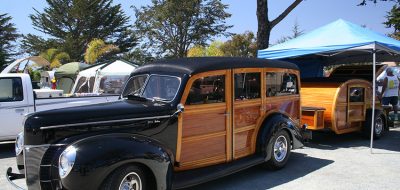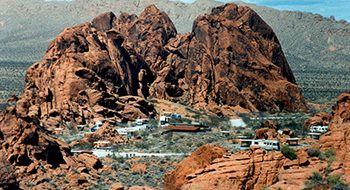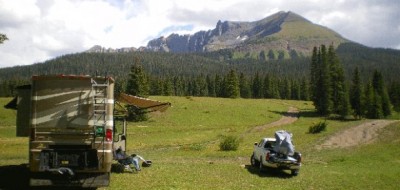By Bob Difley
If you don’t think that adopting conservative driving habits can increase your mileage, consider a test that Ford recently conducted. They put a team together consisting of a NASCAR driver, an engineer, and a hyper-mileage record breaker to see how many miles they could wring out of a tank of gas in a stock Ford Fusion Hybrid. Driving on open roads they got–are your ready–1,445.7 miles out of one tank of gas. That works out to 81.5 mpg.
Now don’t expect to get those kinds of results driving your 40-foot diesel pusher or pulling your Grrand Teton fiver with four slides. But, they proved that you can stretch your mileage. And you can too, by taking a few tips from the team and applying some version of them to your driving.
- Slow down and maintain even pressure on the throttle
- Accelerate gradually, both from a stop and when entering a freeway
- Brake smoothly, avoiding fast stops
- Keep a safe distance between the vehicle in front of you
- Look ahead and anticipate traffic conditions. Slow down well before you need to
- Coast up to red lights and stop signs to avoid wasting fuel waste and wear on the brakes
- Minimize using heater and dash air conditioning to reduce the load on the engine
- Run roof air and close windows at high speeds to reduce aerodynamic drag
- Minimize excessive engine workload by using the vehicle’s kinetic forward motion to climb hills
- Use downhill momentum, rather than applying accelerator, to build speed back up
On a recent trip I had to rent a car for a week. My rented Prius had just over 6,000 miles on it and the monitor screen indicated that the car had averaged 41 miles per gallon up to that point. I thought it would be an interesting test to follow the monitor’s display of mileage that reflected on my driving at the time and, within reason–I was not trying to hyper-drive–adjust my driving speed, acceleration, and coasting to obtain higher mileage.
The tank lasted the entire week, and in fact had quite a bit left, even after a lot of tourist attraction and exploration driving. When I re-filled the tank, the car calculated my mileage for that tank of gas at 55 mph, a 34% increase. I was quite impressed, expecially in the feed back from the car itself as displayed on the monitor. I could easily see how my actions affected the mileage given the instant feedback.
For the last couple years I have managed to increase my mileage on my motorhome (while towing) from 7.2 to 8.8 mpg–a 22% increase–using similar methods of driving. But the Prius computer taught me some new things about my driving that I am now eager to test out on my rig. You too can obtain the same kind of mileage improvements–if you already haven’t. Start practicing now, so that when gas inevitably rises again you will be ready to display your middle digit to OPEC.






Mike
Here’s a link to this year’s Society of Automotive Engineers Mega Mileage event:
http://www.wwj.com/Michigan-Tech-Second-In-SAE-Mega-Mileage-Event/4557408
Over 1,800 MPG! Heck, I’d be happy with 1/100th of that while towing.
Bob Difley
Rick Vogel – I’m waiting for a battery breakthrough that utilizes lite weight strong materials like titanium and kevlar have done for other industries. The breakthrough, whatever its nature, is coming, I”ll bet within a year or two.
Bob Difley
At the end Stewart was easing off the gas and drifting into the turns, slowing his speed, and other “hyper-mileage” actions and managed to finish–and win–the Pocono 500 with barely a sniff of fuel left in his tank. Interesting concept to picture NASCAR drivers practicing fuel economy. Thanks jerry c for the comment.
jerry c
Speakin’ of milege did u see what Tony Stewart did at POCONO, yesterday. to stretch his milege and win. That kid’s have’n fun this year . Pretty cool……………..See ya!
Rick Vogel
a Ford 1 Ton Frame weigh’s almost as a Honda Prius without is’t Body on it!, with engine & tranny & rearend installed, This Dream RV Might work if you place fiberglass panel’s in place of Steel Body-work Place solar panel’s you can build you self for about $200:00 on the rear & side’s & the Roof & maybe the front of an overhead camper you can buy them pretty light now!! Problem is getting a diesel Generator Big enough to due the 30Min. Charge every 100 mile’s, can by electric motor’s anywhere! Keeping the Weight down would be the trick! Maybe a fiberglass body & a Bank of Deep cell batteries,?would Help with this problem? Just thinking but not to Hard! Rick Vogel Army Retired!
Fred
So when can we expect 50 mpg out of a 40′ motorhome?
Fred
Darthvagrant
OUOTE:”Minimize using heater ” (Re: fuel economy)-The vehicle heater uses (free) waste heat from the engine. The amperage draw from the blower motor is so infinitesimal as to not be a consideration. (If it’s on) The air conditioner compressor DOES use considerable torque from the engine, In a small vehicle the deceleration can be felt when the compressor clutch engages. In an RV, assuming 350 to 460 cubic inches, even that parasitic drain is negligible. Tom and Ray Magliozzi have proven mileage in a car is increased with the windows closed even with the air conditioning in use, due to reduced turbulence.
.
I guess it’s an issue of the value of comfort, too.
Ralph Hayes
I was a little curious about the comment: “Run roof air and close windows at high speeds to reduce aerodynamic drag”. Are we talking about air conditioning run by the generator? The generator uses gas too.
Don MacConnel
Great tips and some impressive numbers with that Ford Fusion hybrid. One other help that I’ve used is a manifold vacuum gauge on a gasoline engine vehicle. Keeping the vacuum as high as possible with light-foot driving helps make for more economical driving. It’s sort of a low cost training aid.
The vacuum reading is pretty much proportional to fuel economy. The higher the reading when moving, the greater the fuel economy. It really shows up when there is a headwind on an RV or high frontal area vehicle.
Joe
Nice article, Bob. Conservation using what we already drive can save more than most people think, especially in an RV.
Here’s a fact that surprises most people. You can save more fuel (per distance traveled) by boosting your RV mpg from 8 to 10 than you can by moving from a 30mpg Honda Accord to a 50mpg Toyota Prius.
The Accord will use around 33 gal per 1000 miles, and the Prius will use 20. The switch will save you 13 gal.
At 8mpg, you will put 125 gallons in your tank to travel 1000 miles. At 10mpg, you will use 25 gallons less! (100 gal).
You can save almost twice as much fuel by driving the RV smarter than you can by trading your full size sedan for a Prius. Most people would guess than the Prius switch saves more fuel. After all, it’s a 20mpg jump vs a 2mpg jump.
The real fuel savings in our country (in terms of gallons) over the next few years will come from small changes in the low mpg vehicles, like trucks, buses, and RV’s.